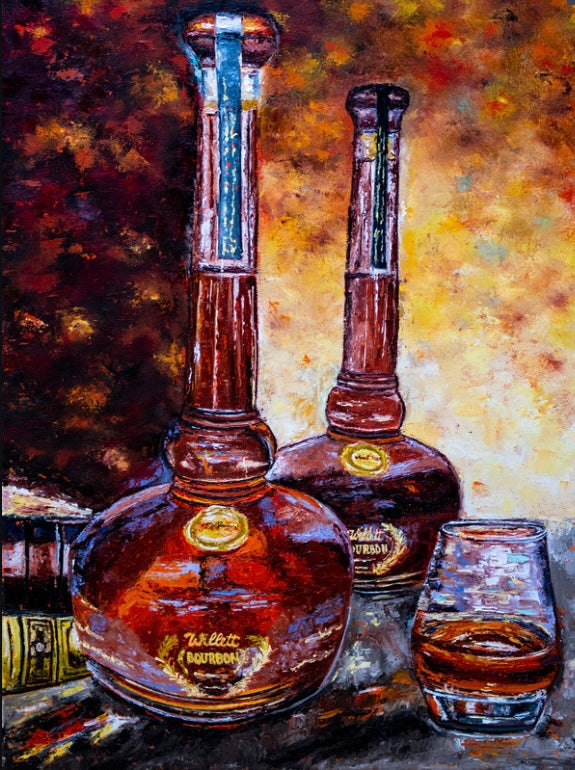Capturing the Essence of Whiskey Art Via Special Aesthetic Representations and Styles
The art of bourbon prolongs beyond the liquid itself, showing up with a range of visual representations that envelop its storied heritage and workmanship. What remains to be discovered is how these progressing styles show not just the scotch itself yet likewise the transforming landscape of imaginative interpretation. Realism Art.
The Background of Scotch Art

As whiskey production spread, so too did the desire to raise its experience through art. From the elaborate engravings on very early barrels to the sophisticated tags of modern containers, each component mirrors a special artistic vision, functioning as an aesthetic narrative of the bourbon's heritage.
In the 19th and 18th centuries, the rise of the commercial change additionally improved bourbon art, resulting in innovative packaging and marketing that caught customer attention. Developers and musicians started trying out with aesthetics, imbuing whiskey-related images with symbolic significances that conveyed concepts of craftsmanship, neighborhood, and tradition.
Today, scotch art remains to develop, mixing conventional techniques with contemporary art kinds. Bourbon Art. This continuous discussion between the spirit and its graph underscores the long-lasting bond in between bourbon and society, enriching the total experience for fanatics worldwide
Iconic Bottle Designs
While numerous aspects add to the appeal of bourbon, legendary bottle designs play a critical function in forming consumer understanding and boosting the total experience. The aesthetic presentation of scotch containers is not merely a visual consideration; it works as a bridge between the customer and the product, evoking feelings and establishing assumptions.
Unique forms, products, and closures can boost a whiskey brand name's identity, making it immediately recognizable on congested racks. The classic Glenfiddich bottle, with its sophisticated tapered shape, shares a feeling of custom and craftsmanship, while the vibrant, contemporary style of the Balvenie bottle shows innovation and elegance. The usage of tinted glass or special structures can suggest the high quality and personality of the scotch within.
Renowned styles frequently incorporate aspects of cultural heritage, representing the brand name's background and link to its roots. Brand Names like Jack Daniel's utilize a straightforward, durable design that resonates with its American whiskey heritage. Eventually, the effect of container layout extends past mere performance; it encapsulates the significance of the brand, welcoming consumers to delight and discover in the rich tapestry of whiskey society.
Label Artwork and Branding
Bottle styles commonly establish the phase wherefore customers can anticipate, however label artwork and branding play a similarly substantial function in connecting a bourbon's identification. The tag acts as the first factor of contact between the item and the customer, enveloping the essence of the whiskey within its aesthetic elements.
Efficient tag artwork integrates imagery, typography, and shade to develop a story that reverberates with the brand's heritage and target market. A label including intricate illustrations and classic font styles may evoke a sense of practice and craftsmanship, appealing to aficionados. On the other hand, bold colors and contemporary style elements could bring in a more youthful market looking for advancement and enjoyment.


Photography and Visual Narration
Recording the significance of whiskey via photography and visual narration is an art form that elevates the brand name experience. This tool transcends simple item representation, delving into the intricate stories that border each container. By utilizing compelling imagery, digital photographers can stimulate emotions anchor that reverberate with customers, eventually forging a deeper link to the whiskey brand.
Visual storytelling in bourbon digital photography commonly makes use of abundant appearances, lights, and make-up to highlight the distinct characteristics of the spirit. The interplay of light and darkness can highlight the amber colors of bourbon, while the choice of background components-- such as rustic barrels or sophisticated glassware-- can enhance the brand's heritage or lifestyle organizations.
Furthermore, recording the ceremonial elements of scotch consumption, from the putting to the sampling, welcomes customers right into a sensory experience, permitting them to picture the flavors and scents that await. Each picture not only showcases the product however also narrates of craftsmanship, tradition, and the moments that bourbon can boost - Whiskey Art. Thus, photography comes to be an effective device in expressing the identity of whiskey brands, placing them within the more comprehensive social landscape
Arising Patterns in Bourbon Art
The advancement of scotch art is significantly shaped by modern trends that mirror more comprehensive societal shifts and customer preferences. One noticeable trend is the assimilation of sustainability into art techniques. Artists are now utilizing recycled materials and eco-friendly processes to produce whiskey-themed pieces, reverberating with ecologically mindful customers. This change not only highlights the significance of sustainability however likewise boosts the narrative bordering whiskey manufacturing.
Furthermore, electronic art has actually risen in popularity, permitting innovative representations of bourbon. Artists are leveraging innovation to craft immersive experiences, such as enhanced reality installations that engage visitors and offer a deeper understanding of bourbon's cultural significance. This trend additionally reaches social media sites systems, where aesthetically striking material amasses interest and fosters neighborhood among enthusiasts.
In addition, partnerships in between scotch brand names and artists are becoming more commonplace. These partnerships yield limited-edition packaging designs and special art work that celebrate both the workmanship of scotch and the creative thinking of artists. As whiskey art proceeds to develop, these emerging fads will most certainly form its future, promoting a dynamic junction of society, sustainability, and innovation within the whiskey neighborhood.
Final Thought
In final thought, the art of bourbon incorporates a diverse range of graphes that mirror its rich heritage and workmanship. From renowned container designs and detailed tag artwork to compelling digital photography, each component contributes to a broader narrative that boosts the customer's experience. As emerging trends, such as digital art and sustainability, remain to form this imaginative landscape, the multifaceted identity find more of whiskey stays an enduring source of cultural link and exploration.

In conclusion, the art of bourbon encompasses a diverse range of visual representations that reflect its rich heritage and craftsmanship.